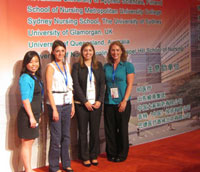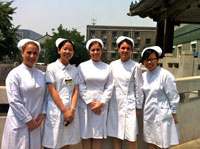Nursing in China and in America—UNC Student Lauren McKenna Explores How They are Alike and How They Differ
By Rick Docksai
Languages and cultures differ enormously across the globe, but people’s health needs are very much the same. Lauren McKenna, a nursing student at University of North Carolina-Chapel Hill, experienced this in a deeply personal way in the summer of 2012 (May 22-June 12, 2012), when she spent three weeks touring a medical school in China.

Earlier that spring, McKenna had helped a Chinese doctoral exchange-student at UNC collect data for a study on pain management. To reward McKenna for her time, the student invited her to visit Peking Union Medical College, her home university in China, for three weeks that summer. McKenna took it up with gusto: It would be her first trip to anywhere outside the United States.
“I think I just took away so much from that perspective, that everything was so new to me,” she said.
Hers was a select group, too. Only three other students—one undergrad and two Master’s students—joined her on this journey.
Much Was the Same, Much Was Different
The four would spend the next three weeks on campus, sitting in on actual classes; and in the hospital, accompanying the nurses on their daily work. The classes were in Chinese, which McKenna did not speak, but that didn’t stop her from following along. The procedures that the students practiced on mannequins, and the catheters and other equipment that they learned to use, were practically identical to those of any U.S. medical classroom.
“Everything seemed very similar in terms of what they were doing and what they were learning,” she said. “Even though I couldn’t understand them, I could see what they were getting at.”
It was in the hospital, however, where McKenna also took in the starkest differences between medicine in the United States and in China. While the diseases and conditions were the same, the resources available to treat them were not.
Peking Union Medical College Hospital was, according to McKenna’s hosts, the best hospital in China. McKenna was seeing Chinese medical practice in its most prestigious and state-of-the-art form.

And so it surprised her how much shorter the staff was on supplies and amenities, compared to the always well-stocked hospitals at Duke University and UNC, where she has been studying. McKenna saw was Peking Union’s doctors and nurses have to resort to reusing syringes, unlike the Duke and UNC-Chapel Hill hospital staff, who throw away and replace every syringe after each use.
Nor were the electric hospital beds and automated IV pumps, standard equipment at the Duke and UNC hospitals, anywhere to be found in Peking Union. Its beds were simple cots, and the IV pumps required nurses to operate them by hand. In fact, most patients didn’t even have rooms—curtains, not walls, separated each patient from the next.
Even the nurses’ uniforms were simpler, according to Lauren. With their white pantyhose and caps, they resembled the garb that Western nurses wore in the mid-twentieth century.
“Walking in, I felt like I was going back in time,” Lauren said.
She grew to greatly admire Peking’s nurses, all the same. She appreciated how they worked to the best of their abilities despite clearly having less.
“They were much more resourceful with what they had,” she said.
It made her question whether U.S. hospitals are truly making the best use of all that they have. When she works outside class as a nursing assistant in UNC’s hospital, she’ll see her coworkers routinely throw items away, sometimes without ever even using them. She finds herself impatient with them for it.
“I definitely see how, in the United States, there is so much waste going on,” she said. “That’s something I’m sensitive to, seeing how in the Peking hospital, they were able to sterilize things without individually wrapping them and throwing them away after. I liked seeing that.”
More Career Options in the States
While McKenna was finding things to admire about Chinese medical practice, the Chinese students grew deeply impressed by what she told them about American medicine. They particularly latched onto her descriptions of “advanced-practice nursing,” nurses taking on many responsibilities that had traditionally belonged to doctors.
As the Chinese students explained, Chinese nurses work under the strict supervision of doctors and are still restricted to traditional nurses’ responsibilities. That an American hospital might let a nurse try on new roles greatly appealed to McKenna’s Chinese counterparts.
“The students were very interested to hear about how, in the States, you could take on more of a provider’s role and get an advanced degree and see where that could take you,” McKenna said.
A Valuable Exchange
The students were, by far, McKenna’s favorite part of the trip. They went out of their way to make her and her fellow American students feel welcome, served as their translators each day, and took them on memorable day trips to see downtown Beijing and the Great Wall of China.

“The greatest part of the trip was interacting with them and becoming friends with them so quickly,” she said. “Even with people that didn’t speak English very well, it was that kind of human connection that was able to be built. Everyone was so kind to me and to my group members.”
China has an ominous image in most Americans’ eyes, as McKenna acknowledges. And yet, many Chinese hold unflattering stereotypes of Americans, as well. McKenna held profound conversations with a few of the students about how Americans and Chinese perceive—and sometimes, completely misunderstand—each other.
“Their portrayals of Americans, it was fun to talk about that,” she said. “A lot of them had never seen anyone who was Caucasian before.”
Seeing What the Future Holds
McKenna is interested to see where China and Chinese medicine heads. She notes the rapid growth of China’s economy and sees vast possibilities for Chinese health care improving—and for more interaction between its nurses and America’s.
“China is definitely coming up and quickly progressing,” she said. “I assume that if I come back in 20 years, I will be very surprised.”
One of Lauren’s classmates and colleagues on this trip, Merle Tai, also shared her experiences and insight. Check out her article: What’s Old, is New, in Chinese Hospital Care, According to UNC Nursing Student Merle Tai